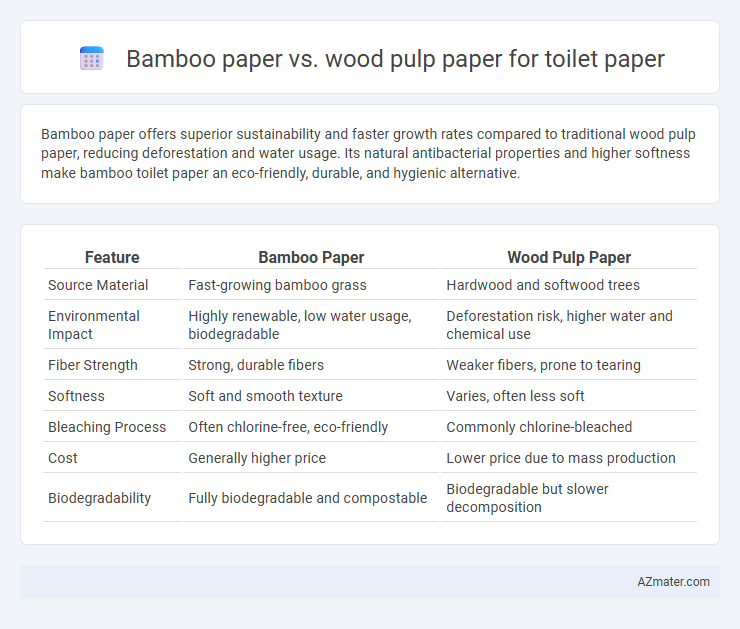Bamboo paper offers superior sustainability and faster growth rates compared to traditional wood pulp paper, reducing deforestation and water usage. Its natural antibacterial properties and higher softness make bamboo toilet paper an eco-friendly, durable, and hygienic alternative.
Table of Comparison
| Feature | Bamboo Paper | Wood Pulp Paper |
|---|---|---|
| Source Material | Fast-growing bamboo grass | Hardwood and softwood trees |
| Environmental Impact | Highly renewable, low water usage, biodegradable | Deforestation risk, higher water and chemical use |
| Fiber Strength | Strong, durable fibers | Weaker fibers, prone to tearing |
| Softness | Soft and smooth texture | Varies, often less soft |
| Bleaching Process | Often chlorine-free, eco-friendly | Commonly chlorine-bleached |
| Cost | Generally higher price | Lower price due to mass production |
| Biodegradability | Fully biodegradable and compostable | Biodegradable but slower decomposition |
Introduction to Bamboo and Wood Pulp Toilet Paper
Bamboo toilet paper is made from fast-growing bamboo fibers, offering a sustainable alternative to traditional wood pulp paper derived from hardwood trees. Bamboo fibers are naturally antimicrobial and break down more quickly in water, reducing environmental impact and sewer blockages. Wood pulp toilet paper typically requires more chemical processing, contributing to higher energy consumption and deforestation concerns.
Environmental Impact Comparison
Bamboo paper for toilet use significantly reduces environmental strain due to bamboo's rapid growth rate and minimal water requirements compared to traditional wood pulp paper, which depends on slow-growing trees and extensive water consumption. Bamboo paper production results in lower carbon emissions and less deforestation, aiding biodiversity preservation and soil conservation. In contrast, wood pulp paper contributes heavily to habitat loss, higher carbon footprints, and increased chemical usage during processing, making bamboo a more sustainable and eco-friendly choice.
Sustainability and Resource Renewability
Bamboo paper for toilet tissue offers superior sustainability due to bamboo's rapid growth rate and minimal need for pesticides, making it a highly renewable resource compared to wood pulp paper derived from slower-growing trees. Bamboo's efficient land use and lower water consumption contribute to reduced environmental impact throughout the production cycle. Wood pulp paper, often sourced from old-growth forests, raises concerns about deforestation and biodiversity loss, highlighting bamboo paper as a more eco-friendly alternative.
Manufacturing Process Differences
Bamboo paper for toilet paper involves processing fibrous bamboo stalks through mechanical or chemical pulping methods, which typically require less water and fewer chemicals compared to wood pulp paper. Wood pulp paper manufacturing relies on harvesting trees and breaking down wood fibers using energy-intensive kraft or sulfite processes that often generate higher emissions and waste. The bamboo process results in faster fiber turnover, contributing to a more sustainable production cycle with lower environmental impact than traditional wood pulp paper manufacturing.
Softness and Texture: User Experience
Bamboo paper for toilet use offers a naturally soft and smooth texture due to its long fibers, creating a gentle touch on sensitive skin. Wood pulp paper, while often softer in premium varieties, can sometimes feel rough or abrasive because of shorter fibers and chemical processing. Users frequently report bamboo toilet paper provides a more comfortable and eco-friendly experience with less irritation compared to traditional wood pulp options.
Absorbency and Strength Analysis
Bamboo paper exhibits higher absorbency compared to wood pulp paper due to its naturally hollow fibers, which retain more liquid. Strength analysis reveals that bamboo paper maintains greater tensile strength and durability when wet, reducing the likelihood of tearing during use. Wood pulp paper tends to be less resilient under moisture stress, making bamboo a superior choice for durable and efficient toilet paper.
Biodegradability and Septic Safety
Bamboo toilet paper is highly biodegradable, breaking down faster than wood pulp paper due to its natural fibers and lack of harsh chemicals. Its septic safety is superior since bamboo fibers decompose quickly, reducing the risk of clogs and septic system damage. Wood pulp paper, especially when treated with chemicals or additives, may take longer to break down and potentially disrupt septic tank function.
Cost and Availability in the Market
Bamboo toilet paper often carries a higher price point than wood pulp variants due to the sustainable cultivation and processing costs associated with bamboo fibers. Availability of bamboo paper is more limited in mainstream markets compared to wood pulp toilet paper, which dominates due to its widespread production and established supply chains. Economies of scale favor wood pulp products, making them more accessible and budget-friendly for most consumers.
Health and Allergen Considerations
Bamboo paper for toilet use is naturally hypoallergenic and antimicrobial, reducing the risk of irritation and allergic reactions compared to traditional wood pulp paper. Wood pulp toilet paper may contain chemical additives and bleaching agents that can trigger sensitivities or exacerbate skin conditions such as eczema. Choosing bamboo paper supports better skin health, especially for those with sensitive or allergy-prone skin, due to its chemical-free and sustainable properties.
Which Toilet Paper is Right for You?
Bamboo toilet paper offers a more sustainable option with faster growth rates and natural antimicrobial properties, making it eco-friendly and gentle on sensitive skin. Wood pulp toilet paper typically provides a softer texture and greater absorbency but has a larger environmental footprint due to deforestation and chemical processing. Choosing the right toilet paper depends on your priorities: opt for bamboo if you value sustainability and hypoallergenic features or wood pulp for a softer, more traditional experience.

Infographic: Bamboo paper vs Wood pulp paper for Toilet paper
 azmater.com
azmater.com